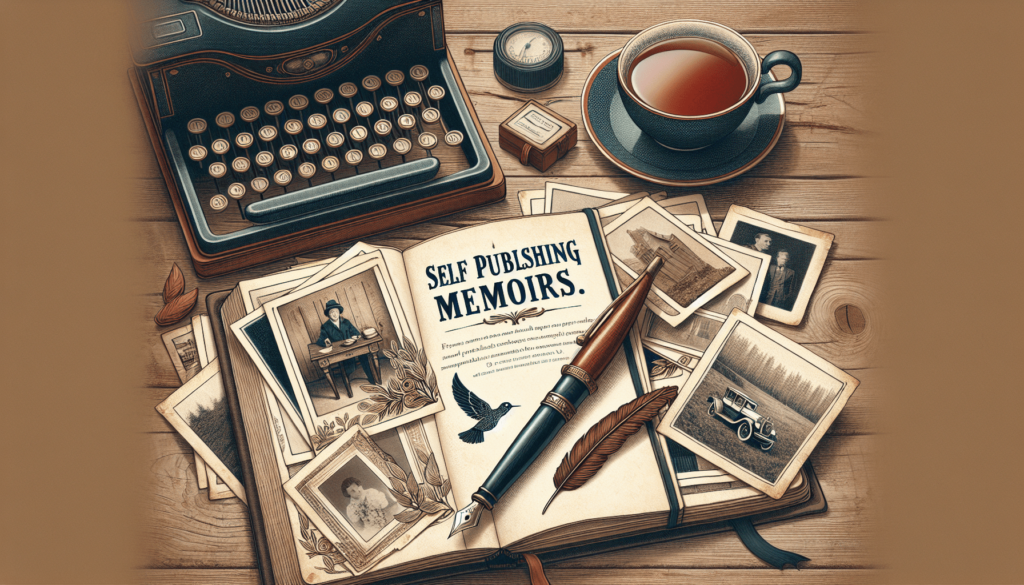Have you ever thought about writing your life story? The journey of self-publishing a memoir can be both thrilling and intimidating. It’s an opportunity to share your experiences, lessons, and the unique tapestry of your life with others.

Learn more about self publishing.
Understanding Memoirs
Memoirs are a special type of literary work focusing on specific themes or events in your life. Unlike a full autobiography, which covers your entire life, a memoir usually zeroes in on particular experiences or periods. This allows for a deeper exploration of emotions, thoughts, and reflections tied to those events.
Why Write a Memoir?
Writing a memoir can serve various purposes. For some, it’s a way to document their journey for their family and future generations. For others, it can be a cathartic process, helping to understand and heal from past experiences. Moreover, memoirs can inspire and resonate with others who might share similar struggles or triumphs.
The Benefits of Self-Publishing
Are you contemplating how to get your memoir into the hands of readers? Self-publishing offers several advantages over traditional publishing. Here’s a quick breakdown:
| Benefit | Description |
|---|---|
| Creative Control | You maintain ownership of your content and decisions. |
| Faster Publication | You can publish on your timeline, instead of waiting for others. |
| Higher Royalties | You receive a larger share of the profits compared to traditional routes. |
| Direct Connection | You interact directly with your audience, building a loyal readership. |
Empowering Your Voice
One of the most noteworthy aspects of self-publishing is that it empowers you to share your authentic voice. Ensuring that your writing reflects who you are can resonate strongly with readers, making your work stand apart in a crowded market.
Preparing to Write
Before you jump into writing your memoir, take some time to prepare. Here are some essential steps to get you started on the right path.
Define Your Purpose
Why do you want to write this memoir? Identifying your purpose can guide your writing process and help keep you motivated. Whether it’s to share your experiences with the world or document your family’s history, knowing your “why” is vital.
Identify Your Audience
Who do you envision reading your memoir? It could be family, friends, or a broader audience. Understanding your target audience can shape the tone and style of your writing. Consider what they might be interested in and how your story can connect with them.
Choose a Focus
With a lifetime of experiences, it can be tempting to write everything down. However, it’s crucial to find a specific focus. This could be a pivotal moment in your life, a relationship, or a theme that runs through your experiences. A well-defined focus will create a cohesive and engaging narrative.
Writing Your Memoir
Having laid the groundwork, it’s time to get to the writing phase. This can be both exhilarating and daunting. Here are some tips to guide you along the way.
Start with an Outline
Creating an outline can provide clarity and direction. It doesn’t have to be overly complicated – simply jot down key events or chapters you want to include. Organize these events chronologically or thematically to keep your narrative structured.
Share Your Story
Engage your emotions while writing. Sharing personal anecdotes and experiences helps to create an emotional bond with the reader. Don’t shy away from vulnerability; it often makes the story more relatable and heartfelt.
Write Regularly
Consistency is key when writing your memoir. Set aside dedicated writing time each day or week. Even if you struggle with writer’s block, writing anything can help maintain the habit and lead to breakthroughs.

Editing and Revising
Once you’ve completed your draft, editing and revising become necessary steps to refine your work. This phase can be just as important as writing the first draft.
Self-Editing Techniques
Start by reading your manuscript with fresh eyes. Look for areas where you can improve clarity and flow. Here are a few techniques to refine your work:
- Read Aloud: Hearing your words can help identify awkward phrases and awkward pacing.
- Take Breaks: Distance yourself from your work for a few days, then return to it to spot issues more easily.
- Check for Consistency: Ensure that your voice, tone, and style remain steady throughout your memoir.
Seeking Feedback
Once you’ve done your self-editing, consider sharing your memoir with trusted friends or family members. They can offer valuable feedback and help identify any areas that may need further attention. You might also think about seeking a professional editor. They can provide an objective perspective and improve the overall quality of your writing.
Choosing to Self-Publish
When your manuscript feels polished and complete, it’s time to consider how you’d like to publish. Self-publishing offers a variety of platforms to choose from, each with unique features.
Popular Self-Publishing Platforms
Here are some popular platforms to help you get started:
| Platform | Description |
|---|---|
| Amazon Kindle Direct Publishing (KDP) | A widely-used platform for publishing e-books and print books. |
| IngramSpark | Allows authors to distribute their books to a global market, including libraries. |
| Barnes & Noble Press | A simple option for self-publishing e-books and print books to Barnes & Noble’s virtual store. |
| Draft2Digital | Offers wide distribution to several retailers and libraries, making it user-friendly. |
Formatting Your Manuscript
Before publishing, ensure that your manuscript is properly formatted. Each platform may have different requirements, but common aspects to check include:
- Font and Size: Use clear, readable fonts like Times New Roman or Arial, typically in 11 or 12-point size.
- Margins: Set appropriate margins to allow for binding if you choose to publish a print version.
- Page Numbers: Ensure your pagination is consistent and formatted correctly for the final product.

Designing the Cover
Your book cover is often the first impression readers will have of your memoir, so invest some time in getting this right.
Importance of an Eye-Catching Cover
An attractive cover design could entice potential readers to open your book. It should represent the essence of your memoir and speak to your target audience. You could either hire a professional graphic designer or explore user-friendly platforms for creating cover designs.
Elements to Consider
When designing your cover, keep the following elements in mind:
- Title and Subtitle: Ensure they are clear and legible from a distance.
- Images: Choose visuals that accurately depict the content and tone of your memoir.
- Color Schemes: Use colors that evoke the emotions you want to convey throughout the book.
Marketing Your Memoir
Self-publishing doesn’t stop at writing and formatting; you also need to market your memoir to ensure it reaches the right readers.
Building Your Author Platform
Create an online presence to connect with your audience before and after your book launch. This could be a blog, a website, or social media accounts. Share insights about your writing process and snippets from your memoir to engage potential readers.
Utilize Social Media
Social media platforms can be powerful tools for reaching your audience. Tailor your content to suit the specific platform, sharing relatable quotes, fun behind-the-scenes moments, or engaging posts about the memoir-writing experience.
Host a Book Launch Event
Consider hosting a launch event where you can present your memoir to friends, family, and your community. This could be done virtually or in-person. Celebrate your accomplishment, read excerpts, and engage with attendees about your experiences.

Embracing Feedback and Growth
Once your memoir is published, prepare to embrace feedback. It’s a natural part of the process that can lead you to growth as a writer.
Handling Reviews
Not everyone will resonate with your story, and that’s okay. Learn to appreciate constructive criticism, and use it as a stepping stone for your future writing projects. Celebrate the positive feedback as well to maintain your motivation.
Reflecting on Your Journey
Take the time to reflect on the entire experience. Writing a memoir is likely to be a transformative journey, teaching you more about yourself and enabling connections with your readers.
Continuing Your Writing Journey
The completion of your memoir doesn’t have to be the end. Consider this experience as a launchpad for future writing endeavors.
Potential for More Projects
You might find that writing your memoir ignites a passion for storytelling. This could lead you to write more memoirs, delve into fiction, or even explore other genres. Each experience will contribute to your growth as a writer.
Engaging with Readers
After your memoir is published, continue engaging with your readers. Consider ways to stay connected, like writing newsletters, hosting events, or maintaining your presence on social media. This engagement not only nurtures your relationship with your audience but can also pave the way for future writing opportunities.

Conclusion
Now that you’ve got a clearer picture of what it takes to self-publish your memoir, consider whether you’re ready to embark on this journey. Remember that sharing your story is a brave and fulfilling endeavor. With the right preparation, persistence, and an open heart, you can create a memoir that resonates beautifully with others.


Comments are closed